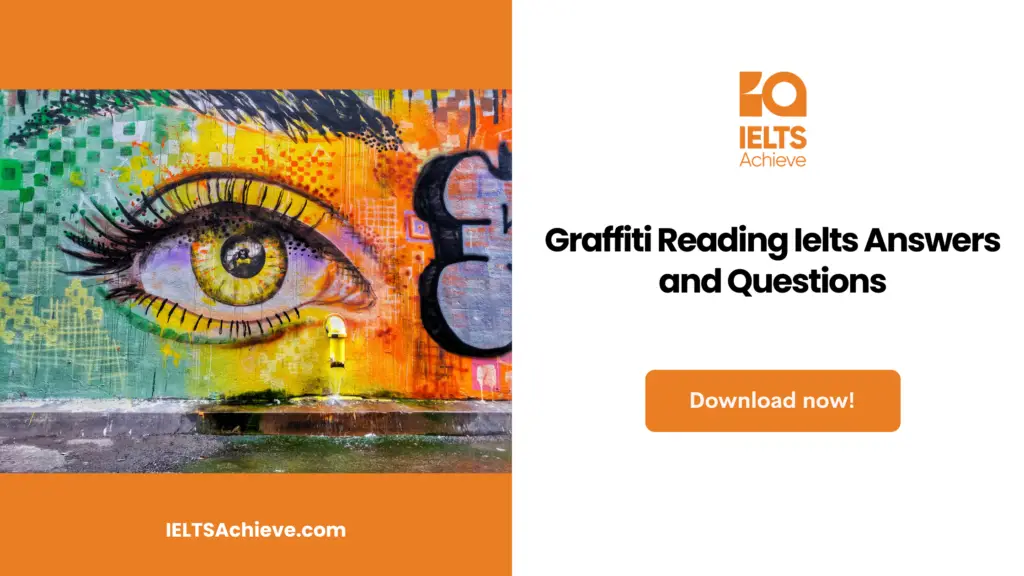The Blog post contains the following IELTS Reading Questions:
- IELTS Reading True/False/Not given
- IELTS Reading Sentence Completion
- IELTS Reading Matching Heading Questions
Stay informed and prepared for success – Explore our comprehensive Reading Test Info page to get valuable insights, exam format details, and expert tips for mastering the IELTS Reading section.
IELTS Reading Passage: Graffiti

Graffiti
- Graffiti comes from the Greek term graphein, which means “to write.” A Latin word, graffito, was derived from this. As a plural noun, graffiti refers to a style of wall painting. Graffiti is any type of art or writing done on a wall, door, or other flat surface. The ‘New York’ or ‘Hip Hop’ style, which originated in New York City in the 1970s, is now synonymous with graffiti. The term “hip hop” has its roots in urban settings. Its roots can be traced back to the rap music of late 1960s/early 1970s Brooklyn/Harlem. Rap, according to music historian Donald Clarke, developed as a backlash to disco. Rap emerged as an alternative to disco, which was centred in the exclusive clubs frequented by New York City’s wealthy elite. Lyrical rhythms and “beatboxing” were used in the music as a means of expressing thoughts and sentiments about urban living. Turntable Scratching’ became an integral aspect of the rhythm, which led to the development of hip hop (the sound created by running the stylus over the grooves of an LP). Hip Hop music provided a new platform for artists to get recognition. In the 1980s, Keith Haring began distributing posters featuring his distinctive cartoon characters and figures. He soon started doodling on actual subway walls and posterboards. His drawings were so distinctive that they were eventually featured in exhibitions and published in books, cementing his status as a serious artist.
- Around the same time that Keith Haring began signing his work “Taki 183,” a messenger service began inscribing the number on all of the packages he brought. It didn’t take long for word of him to spread throughout the city. Both he and Keith Haring became well-known after being the subjects of news stories in periodicals. Many young people, especially those active in rapping, were drawn to the writer’s claim to fame and began using the phrase “Taki 183” as a way to signify the writer’s presence, a modern take on the age-old “I was here” declaration. Together with rapping and breakdancing, graffiti quickly became an integral part of Hip Hop culture. Rap music has become increasingly popular in the United States, whereas breakdancing has declined in its once widespread acclaim. There was a graffiti epidemic in New York City in the late 1970s and early 1980s, but as attention to the problem waned, so did the problem itself. In the mid-1980s, a major network television show featured graffiti, sparking a worldwide epidemic.
- Graffiti artists used to typically work independently, but crews, which may include anywhere from three to ten people, have emerged to tackle larger, more complicated pieces and address safety problems. A person can “down with” (associate) more than one crew. You need to show that you can generate high-quality work and have the capacity to develop your own personal style in order to be invited to join a crew. The “king” or “queen” of a crew is typically the individual who is regarded as having the highest level of artistic skill among the crew members. TAG (short for “Tuff Artists Group”) was the initial crew moniker for a few people that hung out together in the early days. Since then, the term “tag” has evolved to refer to both the act of graffiti writing and the finished product, the tag. When a crew tags, everyone pitches in to write their own individual tags as well as the crew tag. Graffiti is a subculture with its own slang, including words like “piece,” “toy,” “wild-style,” and “racking.”
- At first, people used pens and markers, but they quickly switched to spray paint because of the wide variety of surfaces that it could be employed on. Spray paint has the potential to mark any surface quickly and easily. Unfortunately, the spray nozzles on the cans weren’t strong enough to make larger or brighter paintings. Substituting the caps from aerosol cans like deodorant, insecticide, and others altered the paint’s consistency, making it thinner or thicker. As more and more communities passed legislation prohibiting the use of graffiti tools, creative methods of hiding these instruments emerged. Containers for things like shoe polish and deodorant roll-ons were emptied and then refilled with paint. Furthermore, markers, paint pens, and grease pens bought from art supply stores were used. Taggers will use just about anything that will create a mark on a surface, though the spray can is the weapon of choice.
- The distinct personality of graffiti has evolved over time. Once a form of protest among urban poor, today graffiti is seen as art by people of all socioeconomic backgrounds. Whilst many inner-city youth remain deeply immersed in the graffiti subculture, taggers come from all walks of life, including the uber-rich and the uber-poor. Graffiti artists defy easy categorization. There are both young men and women in the group, who are all talented musicians and artists. A 27-year-old stockbroker was recently apprehended in Philadelphia after driving his BMW to various tagging spots. The simple cursive style is still the most popular, but it has been joined by more complex interlocking letter graphic patterns using various colours, often referred to as “pieces” (from master-pieces). Gang territory markings can also be considered graffiti because they consist primarily of tags and phrases that spread “news” about what’s going on in the area.
- Taggers can purchase a wide range of supplies from graffiti stores, both brick-and-mortar and online. You can get hats, pens, periodicals, tees, bags, shorts with secret compartments, and even colouring books with railcar templates. There are more than 25,000 graffiti sites online, and the vast majority of them support graffiti. Vandalism in the form of graffiti is an issue in virtually all major metropolitan areas throughout the globe. Photos of graffiti from all across the world, including Europe, South America, the Philippines, Australia, South Africa, China, and Japan, can be found on websites that advocate for graffiti. Every year, billions of dollars are spent around the world in an effort to reduce graffiti.
- While most taggers care just about getting their name out there as widely as possible, there are those that seek out abandoned warehouses to hone their skills in peace. In certain cases, these taggers might make $10,000–$12,000 from selling 12-by-48-inch canvases of their work. Two movements developed as a result of graffiti’s entrance into the fine arts community. One, graffiti artists’ style developed thanks to the input of the art world’s collectors, dealers, curators, and other professionals, who probably imparted some of their own knowledge to the up-and-coming graffiti artists. Two, it spread graffiti to more places around the world. To further promote the art form and reduce the quantity of graffiti art that emerges as vandalism, more progressive cities have provided a way for graffitists to execute legal graffiti art. Similarly, graffiti art advocacy groups look for commercial and communal walls in parks where the practice is legal. This demonstrates that the traditional art community accepts some forms of graffiti as legitimate forms of creative expression, especially spray can art.
Unlock your full potential in the IELTS Reading section – Visit our IELTS Reading Practice Question Answer page now!
Recommended Questions:
Renewable Energy IELTS Reading Question with Answer
Graffiti Reading Questions
Questions 1-3
Do the following statements agree with the information given in Reading Passage 1?
In boxes 1-3 on your answer sheet, write
TRUE – if the statement agrees with the writer’s claims
FALSE – if the statement contradicts the writer’s claims
NOT GIVEN – if it is impossible to say what the writer thinks about this
1. To an extent, anti-graffiti laws have been successful in slowing the growth of the problem in some municipalities.
2. Hip Hop culture also gave rise to a new manner of expressing oneself visually.
3.The established art community was hostile towards graffiti artists.
Enhance your skills in identifying information as True, False, or Not Given. Click here to discover expert strategies and techniques for mastering this question type in the IELTS Reading section.
Questions 4-6
Complete each sentence with the correct ending A-F below.
- Use it to express your dissatisfaction with law enforcement.
- It is becoming increasingly difficult to succeed in the art world. Use it to express your dissatisfaction with law enforcement.
- Transcends race, social status, and gender.
- Recognize that poverty in inner-city areas is on the decline.
- They keep their true intentions hidden from law enforcement.
embraces it as a means of expression.
4. Graffiti is thriving in the twenty-first century, as people of all backgrounds have begun to ……………………….
5. Graffiti has evolved as a ……………………….
6. Graffiti artists used a variety of ingenious techniques to ……………………..
Enhance your sentence completion skills in the IELTS Reading section. Click here to access our comprehensive guide and learn effective strategies for filling in missing words or phrases in sentences.
Questions 7 -13
Questions 7-13Reading Passage 1 has seven paragraphs, A-G. Choose the correct heading for each paragraph from the list of headings below.
- Art is becoming more mainstream
- Graffiti Culture
- Tools of the Trade
- Internet Art Styles
- Crossing Boundaries
- Cashing In On Street Music’s Craze
- Trends in Street music
- gradually gaining popularity.
- a Solitary Existence
- From Ancient to Modern
7. Paragraph A: Answer X
8. Paragraph B
9. Paragraph C
10. Paragraph D
11.Paragraph E
12.Paragraph F
13. Paragraph G
Ready to conquer Matching Headings questions? Click here to learn essential tips and techniques for matching headings accurately to paragraphs or sections in the IELTS Reading section.
Unlock your full potential in the IELTS Reading section – Visit our IELTS Reading Practice Question Answer page now!
Recommended Questions:
Renewable Energy IELTS Reading Question with Answer
Graffiti Reading answers
1. Not given
2. True
3. False
4. F
5. C
6. E
7. X
8. VIII
9. II
10. III
11. V
12. VI
13. I

We hope you found this post useful in helping you to study for the IELTS Test. If you have any questions please let us know in the comments below or on the Facebook page.
The best way to keep up to date with posts like this is to like us on Facebook, then follow us on Instagram and Pinterest. If you need help preparing for the IELTS Test, join the IELTS Achieve Academy and see how we can assist you to achieve your desired band score. We offer an essay correction service, mock exams and online courses.

